
Vindobona
Encyclopedia
Vindobona was originally a Celt
ic settlement, and later a Roman
military camp on the site of the modern city of Vienna
in Austria
. Around 15 BC, the kingdom of Noricum
was included in the Roman Empire
. Henceforth, the Danube
marked the border of the empire, and the Romans built fortifications and settlements on the banks of the Danube, including Vindobona.
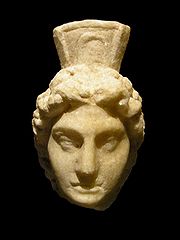
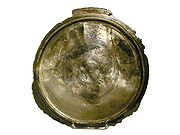 Early references to Vindobona are made by the geographer Ptolemy
Early references to Vindobona are made by the geographer Ptolemy
in his Geographica
and the historian Aurelius Victor
, who recounts that emperor Marcus Aurelius died in Vindobona on the 17 March 180
. Today, there is a Marc-Aurelstraße (English: Marcus Aurelius street) near the Hoher Markt in Vienna.
, of which the regional administrative centre was Carnuntum
. The local inhabitants were probably of Celt
ic and Illyria
n origin.
Vindobona was a military camp with an attached civilian city (Canabae
). The military complex covered an area of some 20 hectares, housing about 6000 men where Vienna’s first district now stands. The Danube marked the border of the Roman Empire, and Vindobona was part of a defensive network including the camps of Carnuntum
, Brigetio and Aquincum
. Under Emperor Trajan
, four legions were stationed in Pannonia.
Vindobona was provisioned by the surrounding Roman country estates (Villae rusticae
).
A centre of trade with a developed infrastructure as well as agriculture and forestry developed around Vindobona. Civic communities developed outside the fortifications (canabae legionis), as well another community that was independent of the military authorities in today's third district. It has also been proven that a Germanic settlement with a large marketplace existed on the far side of the Danube from the second century onwards.
The asymmetrical layout of the military camp, which was unusual for the otherwise standardised Roman encampments, is still recognisable in Vienna’s street plan: Graben, Naglergasse, Tiefer Graben, Salzgries, Rabensteig, Rotenturmstraße. The oblique camp border along today's street Salzgries was probably caused by a tremendous flood of the river Danube
that occurred during the 3rd century
and eroded
a considerable part of the camp. The name “Graben” (English: ditch) is believed to hark back to the defensive ditches of the military camp. It is thought that at least parts of the walls still stood in the Middle Ages, when these streets were laid out, and thus determined their routes. The Berghof was later erected in one corner of the camp.
Wars, administrative and military reforms in the 3rd and 4th century as well as devastating floods led the population to retreat more and more into the military camp. The area lost its importance as a border in the 5th century, and the local population lived within the former fortification.
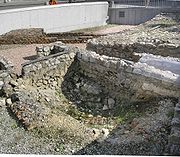
.jpg)
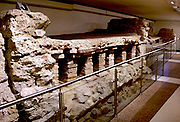 Remains of the Roman military camp have been found at many sites in the centre of Vienna. The centre of the Michaelerplatz has been widely investigated by archaeologists. Here, traces of a Roman legionary outpost (canabae legionis) and of a crossroad have been found. The centrepiece of the current design of the square is a rectangular opening that evokes the archaeological excavations at the site and shows wall remains that have been preserved from different epochs.
Remains of the Roman military camp have been found at many sites in the centre of Vienna. The centre of the Michaelerplatz has been widely investigated by archaeologists. Here, traces of a Roman legionary outpost (canabae legionis) and of a crossroad have been found. The centrepiece of the current design of the square is a rectangular opening that evokes the archaeological excavations at the site and shows wall remains that have been preserved from different epochs.
Part of a Roman canal system is underneath the fire station am Hof .
Directly under the Hoher Markt are the remains of two buildings unearthed during the canalisation works of 1948/49 and made accessible to the public. After further excavation, a showroom was opened in 1961. For this purpose some of the original walls had to be removed; white marks on the floor show the spots where. The buildings, which are separated from one another by a road, housed an officer and his family. In 2008 this Roman ruins exhibit was expanded into the Museum of the Romans. Only a small portion can today be seen, for the majority of the remains are still located underneath the square and south of it.
The remains of the walls date from different phases from the 1st to the 5th century AD. The houses were typical Roman villas, with living quarters and space for working set around a middle courtyard with columned halls.
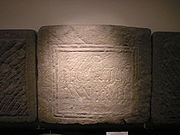 Over 3000 stamped bricks, several stone monuments and written sources prove that several legions, cavalry units and marines were stationed in Vindobona. Around 97. AD, Legio XIII Gemina
Over 3000 stamped bricks, several stone monuments and written sources prove that several legions, cavalry units and marines were stationed in Vindobona. Around 97. AD, Legio XIII Gemina
was responsible for construction of the legionary camps. Because of the wars in Dacia, they were pulled out and redeployed in 101 AD. A decade later, Legio XIIII Gemina Martia Victrix followed. Legio X Gemina
from Aquincum arrived in 114 AD and remained in Vindobona until the 5th century.
About 6000 soldiers were stationed in the Roman camp. Many of them were free from active duty during peaceful times and had other jobs. These so-called immunes were needed for the supply of goods and for the production and maintenance of weapons and commodities. They also extracted stone from quarries and wood from forests, produced bricks, and maintained the streets, bridges and the water system. Administrating the camp and ensuring its security required additional manpower.
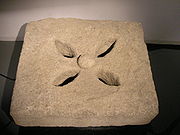 The Romans
The Romans
provided their cities, including Vindobona, with clean potable water through an elaborate systems of "Roman aqueduct
s," canal
s, and large subterranean
pipe
s. Excavations have revealed that Vindobona received its supply through a 17 km long water pipeline . The source is in the Vienna Woods around today's Kalksberg. Wells, latrine
s and the thermae
were supplied with water. Central buildings such as the commander's office and the hospital had their own supplies, as did the settlement outside the camp, where households had their own groundwater
well
s .
Archaeological excavations done over the last 100 years have discovered the following Roman water supply
fragment locations:
Waste from the Roman camp was transported through an elaborate canalisation system that was planned from the beginning. The canals were lined with brick
ed walls and plates and ran beneath the main roads. Gradient
s were used in such a way that the waste water descended through the canals into the Danube River. Since the canals were up to two metres deep, they could be cleaned out regularly. Large waste was probably deposed at the slope of the river. In the civilian settlement, waste was deposed in former water well
s and dumps .

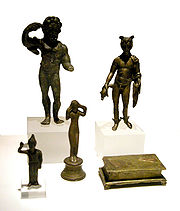 The layout of a Roman camp (castra
The layout of a Roman camp (castra
) was normally standardised. This has helped archaeologists to reconstruct what the camp must have looked like, despite the heavy rebuilding that has taken place in Vienna throughout the centuries. The basic contours of the camp, which was surrounded by a mighty wall with towers and three moats (today the Tiefer Graben, Naglergasse, Graben, and Rotenturmstraße) are identifiable. Along these axes, main roads connected the gates with one other. The main buildings were the commander's headquarters, the Palace of the Legate, the houses of the staff officers, and the thermae. At right angles to these, the soldiers' accommodation, a hospital, workshops, and mews (stables) were constructed.
In one, the lead character's servant, Cicero, trying to get the attention of Lucilla, states, "I served with your father at Vindobona!"
In the other, the lead character asks if anyone in his group of gladiators has served in the army, to which an anonymous fighter responds, "I served with you at Vindobona."
Celt
The Celts were a diverse group of tribal societies in Iron Age and Roman-era Europe who spoke Celtic languages.The earliest archaeological culture commonly accepted as Celtic, or rather Proto-Celtic, was the central European Hallstatt culture , named for the rich grave finds in Hallstatt, Austria....
ic settlement, and later a Roman
Ancient Rome
Ancient Rome was a thriving civilization that grew on the Italian Peninsula as early as the 8th century BC. Located along the Mediterranean Sea and centered on the city of Rome, it expanded to one of the largest empires in the ancient world....
military camp on the site of the modern city of Vienna
Vienna
Vienna is the capital and largest city of the Republic of Austria and one of the nine states of Austria. Vienna is Austria's primary city, with a population of about 1.723 million , and is by far the largest city in Austria, as well as its cultural, economic, and political centre...
in Austria
Austria
Austria , officially the Republic of Austria , is a landlocked country of roughly 8.4 million people in Central Europe. It is bordered by the Czech Republic and Germany to the north, Slovakia and Hungary to the east, Slovenia and Italy to the south, and Switzerland and Liechtenstein to the...
. Around 15 BC, the kingdom of Noricum
Noricum
Noricum, in ancient geography, was a Celtic kingdom stretching over the area of today's Austria and a part of Slovenia. It became a province of the Roman Empire...
was included in the Roman Empire
Roman Empire
The Roman Empire was the post-Republican period of the ancient Roman civilization, characterised by an autocratic form of government and large territorial holdings in Europe and around the Mediterranean....
. Henceforth, the Danube
Danube
The Danube is a river in the Central Europe and the Europe's second longest river after the Volga. It is classified as an international waterway....
marked the border of the empire, and the Romans built fortifications and settlements on the banks of the Danube, including Vindobona.
Early references


Ptolemy
Claudius Ptolemy , was a Roman citizen of Egypt who wrote in Greek. He was a mathematician, astronomer, geographer, astrologer, and poet of a single epigram in the Greek Anthology. He lived in Egypt under Roman rule, and is believed to have been born in the town of Ptolemais Hermiou in the...
in his Geographica
Géographica
Géographica is the French-language magazine of the Royal Canadian Geographical Society , published under the Society's French name, the Société géographique royale du Canada . Introduced in 1997, Géographica is not a stand-alone publication, but is published as an irregular supplement to La...
and the historian Aurelius Victor
Aurelius Victor
Sextus Aurelius Victor was a historian and politician of the Roman Empire.Aurelius Victor was the author of a History of Rome from Augustus to Julian , published ca. 361. Julian honoured him and appointed him prefect of Pannonia Secunda...
, who recounts that emperor Marcus Aurelius died in Vindobona on the 17 March 180
180
Year 180 was a leap year starting on Friday of the Julian calendar. At the time, it was known as the Year of the Consulship of Rusticus and Condianus...
. Today, there is a Marc-Aurelstraße (English: Marcus Aurelius street) near the Hoher Markt in Vienna.
From a military base to a town
Vindobona was part of the Roman province PannoniaPannonia
Pannonia was an ancient province of the Roman Empire bounded north and east by the Danube, coterminous westward with Noricum and upper Italy, and southward with Dalmatia and upper Moesia....
, of which the regional administrative centre was Carnuntum
Carnuntum
Carnuntum was a Roman army camp on the Danube in the Noricum province and after the 1st century the capital of the Upper Pannonia province...
. The local inhabitants were probably of Celt
Celt
The Celts were a diverse group of tribal societies in Iron Age and Roman-era Europe who spoke Celtic languages.The earliest archaeological culture commonly accepted as Celtic, or rather Proto-Celtic, was the central European Hallstatt culture , named for the rich grave finds in Hallstatt, Austria....
ic and Illyria
Illyria
In classical antiquity, Illyria was a region in the western part of the Balkan Peninsula inhabited by the Illyrians....
n origin.
Vindobona was a military camp with an attached civilian city (Canabae
Canabae
Canabae or Canabae legionis was a civilian settlement in the vicinity of a Roman castra for the purpose of housing military dependents and civilian contractors who serviced the base. Many of these communities became cities through synoecism with other communities, some in use today...
). The military complex covered an area of some 20 hectares, housing about 6000 men where Vienna’s first district now stands. The Danube marked the border of the Roman Empire, and Vindobona was part of a defensive network including the camps of Carnuntum
Carnuntum
Carnuntum was a Roman army camp on the Danube in the Noricum province and after the 1st century the capital of the Upper Pannonia province...
, Brigetio and Aquincum
Aquincum
The ancient city of Aquincum was situated on the North-Eastern borders of the Pannonia province within the Roman Empire. The ruins of the city can be found today in Budapest, the capital city of Hungary...
. Under Emperor Trajan
Trajan
Trajan , was Roman Emperor from 98 to 117 AD. Born into a non-patrician family in the province of Hispania Baetica, in Spain Trajan rose to prominence during the reign of emperor Domitian. Serving as a legatus legionis in Hispania Tarraconensis, in Spain, in 89 Trajan supported the emperor against...
, four legions were stationed in Pannonia.
Vindobona was provisioned by the surrounding Roman country estates (Villae rusticae
Villa rustica
Villa rustica was the term used by the ancient Romans to denote a villa set in the open countryside, often as the hub of a large agricultural estate . The adjective rusticum was used to distinguish it from an urban or resort villa...
).
A centre of trade with a developed infrastructure as well as agriculture and forestry developed around Vindobona. Civic communities developed outside the fortifications (canabae legionis), as well another community that was independent of the military authorities in today's third district. It has also been proven that a Germanic settlement with a large marketplace existed on the far side of the Danube from the second century onwards.
The asymmetrical layout of the military camp, which was unusual for the otherwise standardised Roman encampments, is still recognisable in Vienna’s street plan: Graben, Naglergasse, Tiefer Graben, Salzgries, Rabensteig, Rotenturmstraße. The oblique camp border along today's street Salzgries was probably caused by a tremendous flood of the river Danube
Danube
The Danube is a river in the Central Europe and the Europe's second longest river after the Volga. It is classified as an international waterway....
that occurred during the 3rd century
3rd century
The 3rd century was the period from 201 to 300 in the Christian/Common Era.In this century, the Roman Empire saw a crisis, marking the beginning of Late Antiquity. In Persia, the Parthian Empire was succeeded by the Sassanid Empire....
and eroded
Erosion
Erosion is when materials are removed from the surface and changed into something else. It only works by hydraulic actions and transport of solids in the natural environment, and leads to the deposition of these materials elsewhere...
a considerable part of the camp. The name “Graben” (English: ditch) is believed to hark back to the defensive ditches of the military camp. It is thought that at least parts of the walls still stood in the Middle Ages, when these streets were laid out, and thus determined their routes. The Berghof was later erected in one corner of the camp.
Wars, administrative and military reforms in the 3rd and 4th century as well as devastating floods led the population to retreat more and more into the military camp. The area lost its importance as a border in the 5th century, and the local population lived within the former fortification.
Archaeological remains

.jpg)

Part of a Roman canal system is underneath the fire station am Hof .
Directly under the Hoher Markt are the remains of two buildings unearthed during the canalisation works of 1948/49 and made accessible to the public. After further excavation, a showroom was opened in 1961. For this purpose some of the original walls had to be removed; white marks on the floor show the spots where. The buildings, which are separated from one another by a road, housed an officer and his family. In 2008 this Roman ruins exhibit was expanded into the Museum of the Romans. Only a small portion can today be seen, for the majority of the remains are still located underneath the square and south of it.
The remains of the walls date from different phases from the 1st to the 5th century AD. The houses were typical Roman villas, with living quarters and space for working set around a middle courtyard with columned halls.
Evidence for the Roman military presence

Legio XIII Gemina
Legio tertia decima Gemina was one of the most prominent Roman legions. It was one of Julius Caesar's key units in Gaul and in the civil war, and was the legion with which he famously crossed the Rubicon on January 10, 49 BC. The legion appears to have still been in existence in the fifth century...
was responsible for construction of the legionary camps. Because of the wars in Dacia, they were pulled out and redeployed in 101 AD. A decade later, Legio XIIII Gemina Martia Victrix followed. Legio X Gemina
Legio X Gemina
Legio decima Gemina , was one of the four legions used by Julius Caesar in 58 BC, for his invasion of Gaul. There are still records of the X Gemina in Vienna in the beginning of the 5th century. The legion symbol was a bull...
from Aquincum arrived in 114 AD and remained in Vindobona until the 5th century.
About 6000 soldiers were stationed in the Roman camp. Many of them were free from active duty during peaceful times and had other jobs. These so-called immunes were needed for the supply of goods and for the production and maintenance of weapons and commodities. They also extracted stone from quarries and wood from forests, produced bricks, and maintained the streets, bridges and the water system. Administrating the camp and ensuring its security required additional manpower.
Roman canals

Ancient Rome
Ancient Rome was a thriving civilization that grew on the Italian Peninsula as early as the 8th century BC. Located along the Mediterranean Sea and centered on the city of Rome, it expanded to one of the largest empires in the ancient world....
provided their cities, including Vindobona, with clean potable water through an elaborate systems of "Roman aqueduct
Roman aqueduct
The Romans constructed numerous aqueducts to serve any large city in their empire, as well as many small towns and industrial sites. The city of Rome had the largest concentration of aqueducts, with water being supplied by eleven aqueducts constructed over a period of about 500 years...
s," canal
Canal
Canals are man-made channels for water. There are two types of canal:#Waterways: navigable transportation canals used for carrying ships and boats shipping goods and conveying people, further subdivided into two kinds:...
s, and large subterranean
Subterranea (geography)
Subterranea refers to underground structures, both natural and man-made . Some subterranea include:* Bunker* Casemate* Catacombs* Caves** Ice caves* Cave dwellings, Cave house* Cave temple* Cellar* Cenote* Dungeon...
pipe
Pipe
Pipe may refer to:* Pipe , a hollow cylinder following certain dimension rules* Smoking pipe* Pipe or butt, a cask measurement* Pipe , a type of metal casting defect...
s. Excavations have revealed that Vindobona received its supply through a 17 km long water pipeline . The source is in the Vienna Woods around today's Kalksberg. Wells, latrine
Latrine
A latrine is a communal facility containing one or more commonly many toilets which may be simple pit toilets or in the case of the United States Armed Forces any toilet including modern flush toilets...
s and the thermae
Thermae
In ancient Rome, thermae and balnea were facilities for bathing...
were supplied with water. Central buildings such as the commander's office and the hospital had their own supplies, as did the settlement outside the camp, where households had their own groundwater
Groundwater
Groundwater is water located beneath the ground surface in soil pore spaces and in the fractures of rock formations. A unit of rock or an unconsolidated deposit is called an aquifer when it can yield a usable quantity of water. The depth at which soil pore spaces or fractures and voids in rock...
well
Water well
A water well is an excavation or structure created in the ground by digging, driving, boring or drilling to access groundwater in underground aquifers. The well water is drawn by an electric submersible pump, a trash pump, a vertical turbine pump, a handpump or a mechanical pump...
s .
Archaeological excavations done over the last 100 years have discovered the following Roman water supply
Water supply
Water supply is the provision of water by public utilities, commercial organisations, community endeavours or by individuals, usually via a system of pumps and pipes...
fragment locations:
- In the Zemlinskygasse: at numbers 2-4 - (23rd district, found in 1924)
- In the Breitenfurter Straße: at number 422 - (23rd district, in 1959)
- In the Rudolf Zeller-Gasse/Anton-Krieger-Gasse - (23rd district, 1992)
- In Atzgersdorf - (23rd district, 1902–1907)
- In the Tullnertalgasse: at number 76 - (23rd district, 1973)
- In the Lainergasse: at number 1 - (23rd district, 1958)
- In the Wundtgasse - (12th district, 1951)
- In the Rosenhügelstraße: at number 88 - (12th district, 1926)
- In the Fasangartenstraße: at number 49 - (12th district, 1916)
- In the Pacassistraße - (13th district, 1928)
- In the Sechshauserstraße: at number 7 - (15th district, 1879 - leading towards the first district)
Waste from the Roman camp was transported through an elaborate canalisation system that was planned from the beginning. The canals were lined with brick
Brick
A brick is a block of ceramic material used in masonry construction, usually laid using various kinds of mortar. It has been regarded as one of the longest lasting and strongest building materials used throughout history.-History:...
ed walls and plates and ran beneath the main roads. Gradient
Gradient
In vector calculus, the gradient of a scalar field is a vector field that points in the direction of the greatest rate of increase of the scalar field, and whose magnitude is the greatest rate of change....
s were used in such a way that the waste water descended through the canals into the Danube River. Since the canals were up to two metres deep, they could be cleaned out regularly. Large waste was probably deposed at the slope of the river. In the civilian settlement, waste was deposed in former water well
Water well
A water well is an excavation or structure created in the ground by digging, driving, boring or drilling to access groundwater in underground aquifers. The well water is drawn by an electric submersible pump, a trash pump, a vertical turbine pump, a handpump or a mechanical pump...
s and dumps .
Legacies in today’s streets


Castra
The Latin word castra, with its singular castrum, was used by the ancient Romans to mean buildings or plots of land reserved to or constructed for use as a military defensive position. The word appears in both Oscan and Umbrian as well as in Latin. It may have descended from Indo-European to Italic...
) was normally standardised. This has helped archaeologists to reconstruct what the camp must have looked like, despite the heavy rebuilding that has taken place in Vienna throughout the centuries. The basic contours of the camp, which was surrounded by a mighty wall with towers and three moats (today the Tiefer Graben, Naglergasse, Graben, and Rotenturmstraße) are identifiable. Along these axes, main roads connected the gates with one other. The main buildings were the commander's headquarters, the Palace of the Legate, the houses of the staff officers, and the thermae. At right angles to these, the soldiers' accommodation, a hospital, workshops, and mews (stables) were constructed.
Popular culture
- Two lines in the film GladiatorGladiator (2000 film)Gladiator is a 2000 historical epic film directed by Ridley Scott, starring Russell Crowe, Joaquin Phoenix, Connie Nielsen, Ralf Möller, Oliver Reed, Djimon Hounsou, Derek Jacobi, John Shrapnel and Richard Harris. Crowe portrays the loyal Roman General Maximus Decimus Meridius, who is betrayed...
make reference to Vindobona:
In one, the lead character's servant, Cicero, trying to get the attention of Lucilla, states, "I served with your father at Vindobona!"
In the other, the lead character asks if anyone in his group of gladiators has served in the army, to which an anonymous fighter responds, "I served with you at Vindobona."
- The historical novel Votan by Welsh writer John JamesJohn JamesJohn James was an architect particularly associated with Twickenham in west London, where he rebuilt St. Mary's Church and built the house for Hon. James Johnson, Secretary for Scotland, later Orleans House...
begins in "Vindabonum" and imagines 2nd century B.C.E. life there.
Further reading
- Michaela Kronberger: Siedlungschronologische Forschungen zu den canabae legionis von Vindobona. Die Gräberfelder (Monographien der Stadtarchäologie Wien Band 1). Phoibos Verlag, Wien 2005.
- Christine Ranseder e.a., Michaelerplatz. Die archäologischen Ausgrabungen. Wien Archäologisch 1, Wien 2006. ISBN 3-901232-72-9.
- Vindobona. Die Reise in das antike Wien. DVD-Rom, 2004.
- Vindobona II. Wassertechnik des antiken Wiens. DVD-Rom, 2005.

